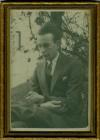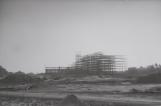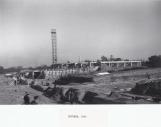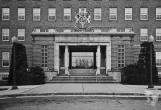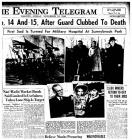1
A dedication ceremony was organized and sod was first turned on the site on the 25th anniversary of Armistice Day, November 11, 1943. Accompanied by Mayor Fred J. Conboy, Minister Ian Mackenzie turned the first sod with wounded Dieppe veteran Private George D. Young of the Toronto Scottish Regiment at his side. On behalf of the City, Mayor Conboy presented the deed to the 180-acre Sunnybrook Park to the Department of Veterans Affairs. He noted: "We could not in a more fitting way pay our tribute of unforgetfulness [sic.]" to those who have sacrificed in the defence of their country, and further, described the City's desire to provide on-site recreational facilities for patients. Leading those assembled in the dedicatory prayer, Lt.-Col. the Rev. Sidney Lambert prayed, "that here may be raised a superstructure, glorious and beautiful," in the name of those remembered on the 25th anniversary of the Armistice.The respected architectural firm of Messrs. Allward and Gouinlock had been retained to design the facility, and had great initial difficulty in maintaining the level of progress expected by the federal government. Partner Hugh L. Allward, designer of the hospital, noted the paradox that existed upon being commissioned in 1943 to design plans: "The invasion of Europe was already scheduled--making the early availability of the Hospital, even in part, a matter of utmost urgency." The hospital, Allward noted "must be so planned as would make possible the orderly and progressive construction of the seperate units of the hospital and achieve occupancy" on a piece by piece basis. He had overruled government officials who envisioned Sunnybrook as a building of great height, among other characteristics. Allward successfully argued that steel was not available in great enough quantities, and even if it were, elevators adequate to serve a tall structure were not. Allward wrote that the
"...choice of materials of which to build the hospital was limited. The Dominion Government, as clients, stipulated the use of Canadian materials and equipment of a Canadian manufacture wherever possible. Wartime limitations had drastically narrowed the selection of materials available--both from the Canadian and American sources. Marked shortages of skilled labour for the fabrication and erection of equipment still further had a bearing on the consideration of construction methods and materials."
These circumstances made the design an ever evolving one, but the urgency of the task made an ally of improvisation and innovation. Grading of the site occurred in the summer of 1944, and in June of that year, the first contracts were tendered for the construction of the Boiler House, Neuro-Psychiatric Unit, and the Up-Patients' Building (which itself housed the Auditorium, lounges, games, billiard, and writing rooms, the bowling alley, dining rooms, kitchens and storerooms, etc.).
The Redfern construction company was awarded the first contracts for the construction of these buildings, and construction had begun by August, 1944. Erecting Canada's largest hospital while the United Nations waged war in Europe and the Pacific proved a difficult task. Redfern suffered a constant shortage of skilled labour and tradesmen. Material and supply shortages necessitated numerous adjustments to design and installation, and the hospital's construction files are littered with "notices of change" sent from the architects to numerous officials. Labour stopages also accounted for numerous delays throughout the construction process, grounded as they were in common demands for more equitable pay, etc. Guinlock remembered that the "prevailing building conditions, with shortages of both labor and materials" offered challenges in each stage of the construction process. His assessment reveals that despite assurances from the government that the building of military hospitals was a top priority, material and labour shortages continued throughout the project.
There were several specific issues that interrupted, delayed or forced changes in the hospital's design during the construction process. Road work intended to facilitate easier access to the hospital, first for contractors and the delivery of essential material, was delayed. The discovery of underground water and sewer infrastructure along the intended path of construction complicated initial plans; and the early onset of winter in 1944 and an especially wet spring of 1945 deteriorated the temporary roadways used by Redfern to access the site. Naturally, these logistical difficulties slowed progress in the early stages of construction.
Hugh Allward has written that "procurement problems were encountered almost immediately and it was frequently found necessary to adopt alternative materials and methods of construction in order to maintain progress on the work." Early on in the construction process, it became apparent that the Milton Brick Company of Montreal, the company contracted to produce the more than 1.4 million base bricks, was itself facing problems similar to those confronted at the Sunnybrook site. It, too, was concerned about insufficient equipment and labour, being forced to close production for six weeks due to a labour shortage and the "condition of their present machinery." Initially, they were only able to ship a meagre 20,000 bricks to begin the construction of the active treatment centre. Appeals were made from the Department of Veterans Affairs to the War Assets Corporation to do everything necessary to assist Milton Brick in meeting the stipulations of the contract. Throughout the project, the contractors suffered skilled labour shortages. Most notably in demand throughout, and especially in the early stages of construction were bricklayers to finish the structure's facade. Steel was in high demand, and records note that the Truscon Steel Company had their production interrupted by a sympathy strike in support of the Ford workers at their plant in Walkerville.
By August, 1945, the labour situation had become more strained when the carpenters, plasterers and cement finishes went on strike. When they returned to work, they did so in diminished numbers. By early September, the contractors were short 25 bricklayers and 50 carpenters. According to a meeting between union groups and the Department of Labour, this was in part due to the operation of "speculative builders" operating in the area who were willing to pay a premium to labourers, which contravened the government's regulation of wages in the district. In order to expedite the pressing work at Sunnybrook, the Department of Labour was advised to enforce wage standards in the area more diligently, and offer its own workers greater advantages. Significantly, the union workers employed by the government to construct the hospital would continue to receive 40 cents per diem for travel expenses, the increase in pay they had requested was granted, and the seemingly "vogue" practice of receiving nine days pay for every eight days worked was recommended. Despite this, again in July of 1946, The Toronto Daily Star reported that "a shortage of plasterers is delaying construction. Forty acres of wall surface remains to be plastered."
Hall, Robert. "".that here may be raised a superstructure, glorious and beautiful:" The Greater Toronto Veterans Hospital Committee and the Unveiling of Sunnybrook Veterans Hospital." Sunnybrook Archives
1.1 Oct. (2011).
7
Image of entrance to the newly constructed Sunnybrook Hospital.26 September 1946
Toronto, Ontario, Canada
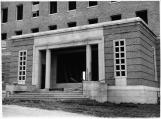 Credits:
Credits:York University Libraries, Clara Thomas Archives & Special Collections, Toronto Telegram fonds, image ASC07121
Telegram staff
